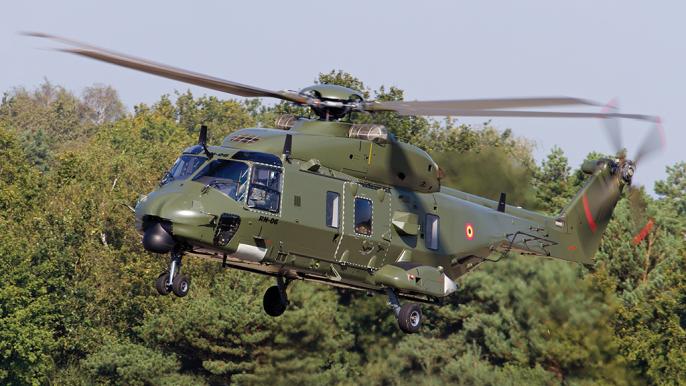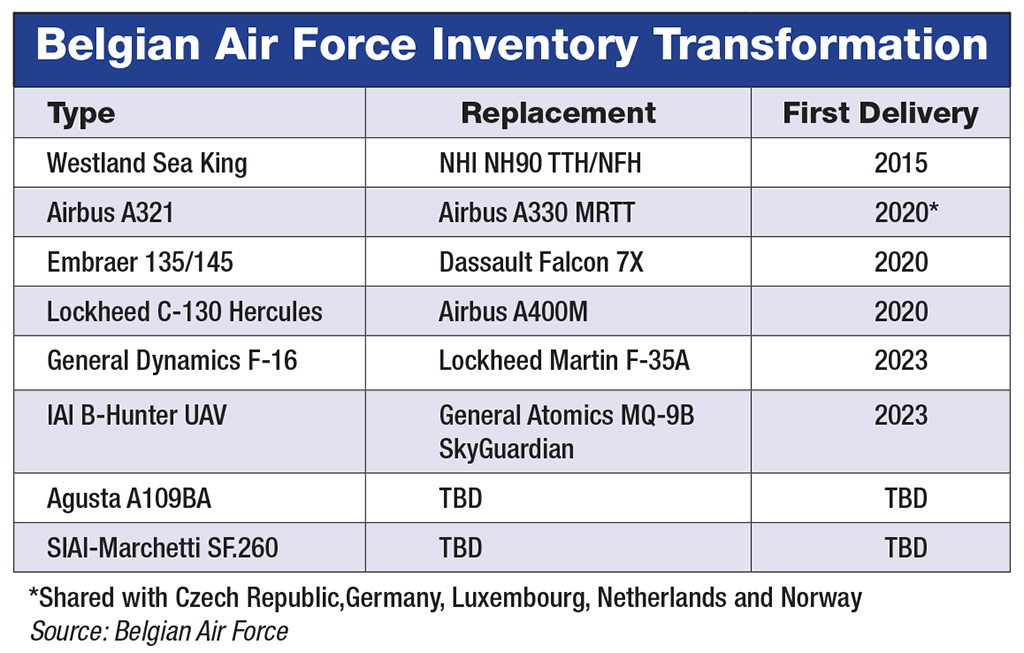
By the end of the decade, Belgium should have completed an air force transformation that will have replaced almost every type in the inventory.
Along with new fighters in the form of the Lockheed Martin F-35, the Belgian Air Component will induct new airlifters, invest in and help generate a new European tanker capability, and introduce a new, modern unmanned surveillance capability.
It is a radical step for an air force traditionally cautious about introducing new technology.
- Belgium’s first F-35s will arrive in 2023
- Luxembourg’s only A400M will be co-located with Belgian fleet
Col. Geert De Decker, Air Component chief of staff, told Aviation Week during an air force flight to Lithuania: “It is often better to learn from the first users," he said. "We do not have the luxury of the people or the money to go through the motions. We would rather wait a little longer and get the corrected and final version.”
The approach goes some way toward explaining how Belgium ended up being the last of the Airbus A400M partner nations to receive the type, with the first expected to arrive later this year. The country was also the last of the four European Participating Air Forces that purchased F-16s during the late 1970s—with Denmark, the Netherlands and Norway—to select its replacement. Like the others, it opted for the F-35 (34 of them).
The F-35As will be Block 4, Technology Refresh 3-standard aircraft. The first F-35s will be delivered in 2023, and the aircraft will arrive in batches of four from 2024-28 and in 2030. A batch of five will be delivered in 2029. The first aircraft will not be based in Belgium until 2025.
Belgium has chosen to split the fleet between two air bases, Florennes in Wallonia and Kleine Brogel in Flanders. Eight of the aircraft will also be stationed at Luke AFB, Arizona, until 2028.
Splitting the aircraft between the two Belgian bases will boost the operational resiliency of the fleet, noted De Decker. “In operations you need a second base to divert to, so having this resilience and redundancy is operationally sound as well,” he said.
The fleet will be the second-smallest in Europe after Denmark’s, which De Decker said may indicate the air force must “adapt the level of ambition we have right now.”
“With the numbers right now, we are falling short of the NATO targets we have,” he said. “So we will have to see what we can do.”

Belgium, like its neighbors in the Netherlands, has regularly punched above its weight in supporting NATO’s overseas operations—with Belgian F-16s operating over Afghanistan, Libya, the Balkans and most recently in Iraq and Syria, while also supporting air-policing missions such as Baltic Air Policing, which the air force is currently leading in Lithuania.
However, it has increasingly been able to share that burden with the Netherlands. The two nations already share the quick-reaction alert mission for national air policing. Every four months, they rotate policing the skies of both countries as well as those of Luxembourg. Agreements are in place that allow a Belgian aircraft to intervene in an incident over the Netherlands and vice versa. The two countries also share a deployment to Jordan in support of operations against the Islamic State group.
If the Netherlands sends fighters, Belgium provides the force protection, and vice versa.
The hope is that as each country introduces the F-35, the other will be able to fill in gaps, freeing up resources. “That is a work in progress,” said De Decker. “But this is our way of working. With reduced numbers [of personnel] and budgets, we [European air forces] must learn and support each other; it is logical that we do that.”

Belgian exchange pilots are flying with the UK Royal Air Force to build experience on the A400M.
Brussels is purchasing seven A400Ms, but will ultimately have access to eight airframes. Luxembourg’s single aircraft will be integrated into the Belgian fleet and based in Brussels, with Luxembourg providing additional pilots and ground personnel.
“We are looking forward to the A400M,” said De Decker, “It is a modern aircraft with a lot of capabilities, and we are hopeful that reliability will increase by the time it arrives.”
“We are doing great stuff with the C-130 [Hercules], but it is getting old, [and] the A400M is much more flexible,” he added.
Another new capability being introduced is the General Atomics MQ-9B SkyGuardian medium-altitude, long-endurance UAV. The platform will replace Belgium’s B-Hunter, a derivative of the Israel Aerospace Industries Hunter platform, which performs regular flights in Belgian airspace, albeit segregated from other users. With the MQ-9B fully certified, the air force is hopeful the aircraft can be operated in nonsegregated airspace. However, a capability gap is emerging between the B-Hunter withdrawal from service in 2021 and the MQ-9B’s introduction in 2023, which De Decker is hoping can be addressed by sending Belgian personnel to be embedded in MQ-9 operations with France or the UK. Four MQ-9B airframes will be purchased, along with two ground control stations.
Belgium has also made investments in the Netherlands-led Multinational Multirole Tanker Transport Fleet (MMF). Purchasing 1,000 hr. a year has led to the ordering of an additional Airbus A330 tanker, bringing the fleet to eight aircraft. Buying into the scheme means the air force can now reduce its reliance on leased commercial aircraft for transport flights. Currently, the air force is leasing an Airbus A321 for its transport flights, and previously used an A330-300. Both were leased from Portuguese operator Hi Fly.
The air force is in the process of retiring its fleet of Embraer 135 and 145 transports and will introduce Dassault Falcon 7X business jets for VIP duties.
Training is also being transformed. In January, the air force retired its last Dassault/Dornier Alpha Jet trainer, transitioning fast-jet training from Cazaux, France, to the Euro-NATO Joint Jet Pilot Training Program at Sheppard AFB, Texas. Training for multiengine types continues in France, at Avord, while helicopter training is also performed in France at Dax. The only air force flying training currently being performed in-country is the pilot screening process using the SIAI-Marchetti SF.260, one of the few types in the air force not being replaced—at least for now.
A replacement program could emerge in the mid-2020s, De Decker has suggested.
The air force, like the rest of the Belgian Armed Forces, is also facing a complex recruitment challenge exacerbated by aging personnel. Reports in the Belgian media last year suggested that the Belgian Armed Forces needed to recruit around 13,000 personnel in just four years to make up for an expected 11,000 personnel expected to retire by 2024. Cuts in the defense budget, working conditions, pay and competition from the private sector have all contributed to the recruitment challenge.
“We are still filling pilot slots,” said De Decker. “Today we might have five candidates for one slot, previously we would have 35.” Instead the “main choke points” are in technical staff and air traffic controllers, he adds.
There is a hope that the new investments and technology being introduced will attract a new generation of recruits. De Decker said the introduction of types such as the F-35 will have a transformative effect not only on the air force, but the other armed services as well.
“We need to create awareness in our defense forces,” he said. “Platforms like the F-35 are a unique tool that can be used by all of the armed forces.”
